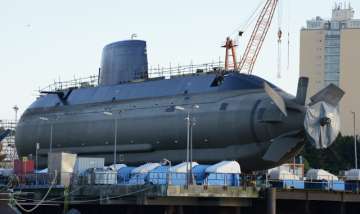After a long delay of ten years, India has finally initiated the ‘mother of all underwater defence deals’, which involves building six advanced stealth submarines by France, Germany, Russia, Sweden, Spain and Japan in collaboration with an Indian shipyard for an estimated Rs 70,000 crore, says a Times of India report.
This conventional submarine programme known as Project-75 (India) had been languishing in politico-bureaucratic apathy, files and committees ever since it got the government’s approval in November 2007.
But now, the project is likely to be the first mega project under the new ‘strategic partnership’ policy finalised by the Defence ministry in May. However, the process is still in its early stages.
The report cited officials saying that the six shipbuilders – Naval Group-DCNS (France), ThyssenKrupp Marine Systems (Germany), Rosoboronexport Rubin Design Bureau (Russia), Navantia (Spain), Saab (Sweden) and the Mitsubishi-Kawasaki Heavy Industries combine (Japan) – will have to first respond to the RFI (request for information).
After that, the Navy will formulate the NSQRs (naval staff qualitative requirements) before the formal RFP (request for proposal) is issued to the six shipbuilders for submitting their technical and commercial bids for evaluation. Meanwhile, the selection of the Indian shipyard for the strategic partnership with the foreign collaborator will be done.
“It may take around two years for the original equipment manufacturer (OEM)-Indian shipyard combine to be down-selected. Moreover, the first new submarine will be rolled out only seven to eight years after the final contract is inked. But the aim is to fast-track the entire process,” Times of India quoted a senior defence official as saying.
The Navy wants the six diesel-electric submarines to have land-attack cruise missiles, air-independent propulsion for greater underwater durability, and the capability to integrate indigenous weapons and sensors as and when they are developed.
According to approved plans, the Navy should have 18 diesel-electric submarines as well as six nuclear-powered submarines with long-range nuclear-tipped missiles (SSBNs) for effective deterrence against China and Pakistan.
However, the force is still grappling with 13 old conventional submarines, of which at least 10 are over 25 years old, apart from two nuclear-powered submarines, INS Arihant (SSBN) and INS Chakra (SSN).
Latest World News
